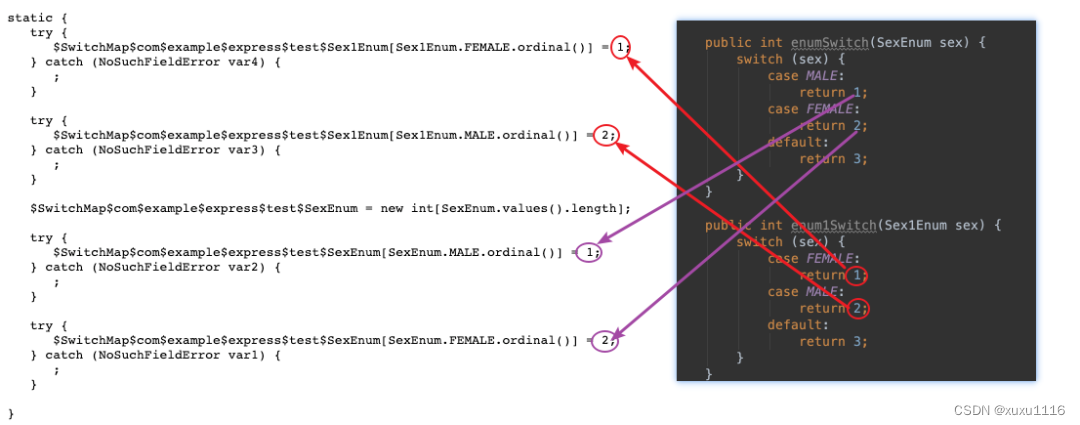目录
- 前言
- 一、结论
- 二、枚举类型是咋变成 int 类型的?
- 三、String 类型是咋变成 int 类型的?
- 四、它们的包装类型支持吗?
前言
我们知道Java Switch 支持byte、short、int类型,在JDK 1.5 时,支持了枚举类型,在 JDK1.7时,又支持了String类型。那么它为什么就不能支持long类型呢,明明它跟 byte、short、int 一样都是数值型,它又是咋支持 String 类型的呢?
一、结论
不卖关子,先说结论:
switch 底层是使用 int 型 来进行判断的,即使是枚举、String类型,最终也是转变成 int 型。由于 long 型表示范围大于
int 型,因此不支持 long 类型。
下面详细介绍下各个类型是如何被转变成 int 类型的,使用的编译命令为 javac,反编译网站为:http://javare.cn
二、枚举类型是咋变成 int 类型的?
在没有实验之前,我想当然的认为它是不是根据枚举的 int 型字段来计算的(因为一般枚举都是一个int型,一个string型),但是转念一想,万一枚举没有 int 型字段呢,万一有多个 int 型字段呢,所以肯定不是这样的,下面看实验吧。
定义两个枚举类,一个枚举类有一个int型属性,一个string型属性,另外一个枚举类只有一个string属性:
public enum SexEnum {MALE(1, "男"),FEMALE(0, "女");private int type;private String name;SexEnum(int type, String name) {this.type = type;this.name = name;}
}
public enum Sex1Enum {MALE("男"),FEMALE("女");private String name;Sex1Enum(String name) {this.name = name;}
}
然后编写一个测试类,并且让两个枚举 switch 的 FEMALE 和 MALE 对应的返回值不同:
public class SwitchTest {public int enumSwitch(SexEnum sex) {switch (sex) {case MALE:return 1;case FEMALE:return 2;default:return 3;}}
public int enum1Switch(Sex1Enum sex) {switch (sex) {case FEMALE:return 1;case MALE:return 2;default:return 3;}}
}
将这几个类反编译下:
// SexEnum.class
public enum SexEnum {MALE(1, "男"),FEMALE(0, "女");private int type;private String name;// $FF: synthetic fieldprivate static final SexEnum[] $VALUES = new SexEnum[]{MALE, FEMALE};private SexEnum(int var3, String var4) {this.type = var3;this.name = var4;}}// Sex1Enum.class
public enum Sex1Enum {MALE("男"),FEMALE("女");private String name;// $FF: synthetic fieldprivate static final Sex1Enum[] $VALUES = new Sex1Enum[]{MALE, FEMALE};private Sex1Enum(String var3) {this.name = var3;}}
反编译这两个枚举类,发现其中多了一个 $VALUES 数组,内部包含了所有的枚举值。继续反编译测试类:
// SwitchTest$1.class
import com.example.express.test.Sex1Enum;
import com.example.express.test.SexEnum;// $FF: synthetic class
class SwitchTest$1 {// $FF: synthetic fieldstatic final int[] $SwitchMap$com$example$express$test$SexEnum;// $FF: synthetic fieldstatic final int[] $SwitchMap$com$example$express$test$Sex1Enum = new int[Sex1Enum.values().length];static {try {$SwitchMap$com$example$express$test$Sex1Enum[Sex1Enum.FEMALE.ordinal()] = 1;} catch (NoSuchFieldError var4) {;}try {$SwitchMap$com$example$express$test$Sex1Enum[Sex1Enum.MALE.ordinal()] = 2;} catch (NoSuchFieldError var3) {;}$SwitchMap$com$example$express$test$SexEnum = new int[SexEnum.values().length];try {$SwitchMap$com$example$express$test$SexEnum[SexEnum.MALE.ordinal()] = 1;} catch (NoSuchFieldError var2) {;}try {$SwitchMap$com$example$express$test$SexEnum[SexEnum.FEMALE.ordinal()] = 2;} catch (NoSuchFieldError var1) {;}}
}
首先生成了一个名为 SwitchTest$1.java 的链接类,里面定义了两个枚举数组,这两个数组元素添加的顺序完全和测试类中 switch 类调用的顺序一致。

枚举元素在数组中的下标由 ordinal() 函数决定,该方法就是返回枚举元素在枚举类中的序号。
这里我们其实就已经知道了,在 switch 语句中,是根据枚举元素在枚举中的序号来转变成 int 型的。最后再看下测试类的反编译结果验证下:
// SwitchTest.class
import com.example.express.test.Sex1Enum;
import com.example.express.test.SexEnum;
import com.example.express.test.SwitchTest.1;public class SwitchTest {public int enumSwitch(SexEnum var1) {switch(1.$SwitchMap$com$example$express$test$SexEnum[var1.ordinal()]) {case 1:return 1;case 2:return 2;default:return 3;}}public int enum1Switch(Sex1Enum var1) {switch(1.$SwitchMap$com$example$express$test$Sex1Enum[var1.ordinal()]) {case 1:return 1;case 2:return 2;default:return 3;}}
}
三、String 类型是咋变成 int 类型的?
首先我们先知道 char 类型是如何变成 int 类型的,很简单,是 ASCII 码,例如存在 switch 语句:
public int charSwitch(char c) {switch (c) {case 'a':return 1;case 'b':return 2;default:return Integer.MAX_VALUE;}
}
反编译结果为:
public int charSwitch(char var1) {switch(var1) {case 97:return 1;case 98:return 2;default:return Integer.MAX_VALUE;}
}
那么对于 String 来说,利用的就是 hashCode() 函数了,但是 两个不同的字符串 hashCode() 是有可能相等的,这时候就得靠 equals() 函数了,例如存在 switch 语句:
public int stringSwitch(String ss) {switch (ss) {case "ABCDEa123abc":return 1;case "ABCDFB123abc":return 2;case "helloWorld":return 3;default:return Integer.MAX_VALUE;}
}
其中字符串 ABCDEa123abc 和 ABCDFB123abc 的 hashCode 是相等的,反编译结果为:
public int stringSwitch(String var1) {byte var3 = -1;switch(var1.hashCode()) {case -1554135584:if(var1.equals("helloWorld")) {var3 = 2;}break;case 165374702:if(var1.equals("ABCDFB123abc")) {var3 = 1;} else if(var1.equals("ABCDEa123abc")) {var3 = 0;}}switch(var3) {case 0:return 1;case 1:return 2;case 2:return 3;default:return Integer.MAX_VALUE;}
}
可以看到它引入了局部变量 var3,对于 hashCode 相等情况通过 equals() 方法判断,最后再判断 var3 的值。
四、它们的包装类型支持吗?
这里以 Integer 类型为例,Character 和 Byte 同理,例如存在 switch 语句:
public int integerSwitch(Integer c) {switch (c) {case 1:return 1;case 2:return 2;}return -1;
}
反编译结果为:
public int integerSwitch(Integer var1) {switch(var1.intValue()) {case 1:return 1;case 2:return 2;default:return -1;}
}
可以看到,是支持包装类型的,通过自动拆箱解决。
那万一包装类型是 NULL 咋办,首先我们知道 swtich 的 case 是不给加 null 的,编译都通不过,那如果传 null 呢?
答案是 NPE,毕竟实际还是包装类型的拆箱,自然就报空指针了。







)


)









